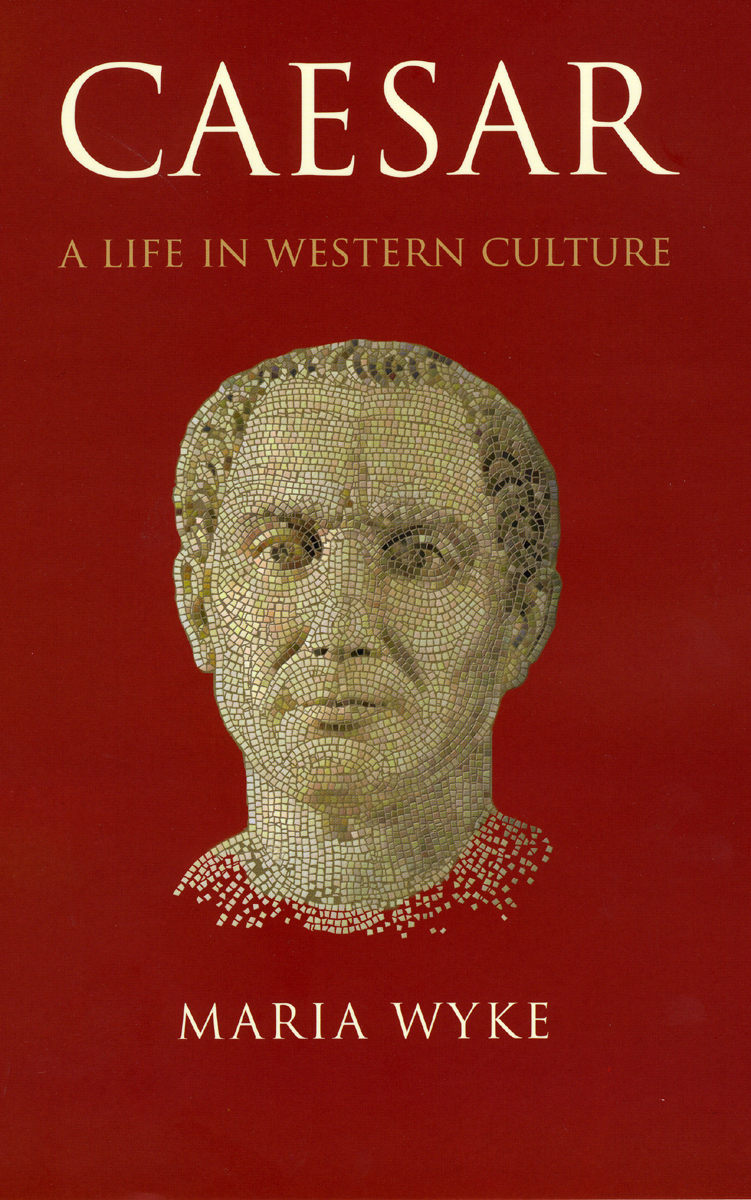An excerpt from
Caesar
A Life in Western Culture
Maria Wyke
CAESAR’S CELEBRITY
From fame to fable
Julius Caesar hit the headlines in late summer 2003 when a perfectly preserved white marble head displaying his likeness was discovered on a small island in the southern Mediterranean. Although it was quickly identified as another posthumous Roman portrait, it was presented as more refined and pristine than the few other busts which have been most closely associated with the statesman’s name. Italian archaeologists also claimed its physiognomy (the lines around the brows, the sad expression, the distant gaze) revealed both Caesar’s authority and the strains under which it placed him, with perhaps even a suggestion of foresight into his impending demise and that of his whole epoch. Found on Pantelleria, a holiday hideaway for pop stars and Hollywood celebrities, the marble head was then shot by the fashion photographer Fabrizio Ferri to accompany newspaper and magazine reports. Julius Caesar’s face had emerged elegantly from the warm waters of the Mediterranean into contemporary celebrity culture.
Why is Julius Caesar the most famous of all Romans? Why not the dictator Sulla, the military conqueror Pompey, or the emperor Augustus? Caesar’s exceptional talents, his actions, and his murder, as they figure in many ancient narratives, all assist in the process of turning the Roman dictator into an embodiment of a profound transformation in the history of Western civilization from republic to empire. Caught on the threshold of epochal change, Julius Caesar is also deeply implicated in it. Consequently his biography has taken on monumental dimensions, and matured into a foundational and formative story. It has possessed extraordinary and lasting appeal because his image has not been fixed. Whether as founder or destroyer, Julius Caesar’s life has become a point of reference from which to explore concerns about conquest and imperialism, revolution, dictatorship, liberty, tyranny and political assassination. Used as model or anti-model for warfare and statecraft, he has also been invoked to pose questions about more personal merits (such as audacity, risk-taking, courage and glory, leadership, good fortune and fame, even immortality) and about personal failings (such as arrogance, ambition, extravagance, lust and cruelty). Even from the time of his own writing about himself, Julius Caesar’s life has been arranged, fictionalized, and sensationalized so as to become a set of canonic events and concepts whose telling reveals much more than just the minutiae of one individual’s existence. Julius Caesar was a Roman leader of flesh and blood who existed in real time. He is also a quasi-mythic protagonist in the development of Western culture.
Fame
From the ancient sources (including Julius Caesar’s own writing), there emerges the portrait of the most charismatic and talented Roman of his time. A spectacular and varied list of gifts, skills and capacities reveal a figure without precedent: a man of wide learning and sophisticated tastes, but also physical strength, endurance, courage, focus and energy; an eloquent and lively orator, a versatile and direct writer; a supremely shrewd general and magnetic leader, an astute and dynamic politician and statesman, an effective administrator, a clever self-publicist and showman, a successful lover, a favourite of fortune.
Blessed with such characteristics, and acting notionally in the name of the senate and the people of republican Rome, Julius Caesar conquered Gaul, vastly extended the boundaries of Roman rule, laid the foundations of France, and initiated the formation of what would become modern Europe. Then, in crisis-ridden Rome, he instigated a civil war against the republic’s supporters and their leader Pompey, usurped power and established a permanent dictatorship. His populist, autocratic mode of government was cut short by his murder but eventually, after more than a decade of further civil war between his aspiring successors and his assassins, an enduring imperial monarchy was put in its place.
The Roman general and dictator constantly cultivated a public image for himself that was larger than life in order to arouse admiration and, therefore, increase his political authority, and also to achieve a lasting recognition (or fama) for those great deeds of state. Beyond the games and triumphs which he staged, and the honorific distinctions with which he adorned himself, his own commentaries on the war in Gaul and the subsequent civil war constitute a successful and enduring example of his self-promotion in pursuit of fama. In these works, the author refers to himself as ‘Caesar’—a separable entity whose reputation can be favourably manipulated, polished and inflated. While the narratives affect third-person objectivity, a breathless haste and the limitations imposed by battlefield reporting, they tell tales of vast territories annexed and enemies utterly outwitted and overwhelmed.
Set alongside (and at times against) this self-presentation of ‘Caesar’ are the depictions which emerge from the works of contemporaries such as the poet Catullus, the orator and statesman Cicero, or the political historian Sallust. In his letters, speeches and philosophical essays, Cicero in particular offers no consistency: open hostility at times, at times expedient eulogy, frequently an oscillation between admiration and distaste. On at least one occasion, he expresses an apprehension that Julius Caesar will be granted the enduring fame he so desires, only for it to prove highly volatile:
Posterity will be staggered to hear and read of the military commands you have held and the provinces you have ruled … battles without number, fabulous victories, monuments and shows and Triumphs. And yet unless you now restore this city of ours to stability by measures of reorganization and lawgiving, your renown, however far and wide it may roam, will never be able to find a settled dwelling-place or firm abode. For among men still unborn, as among ourselves, there will rage sharp disagreements. Some will glorify your exploits to the skies. But others, I suggest, may find something lacking, and something vital at that. (Cicero, pro Marcello 28û9. Trans. M. Grant, 1969)
Cicero found himself in a difficult political situation after he had been pardoned by Caesar for supporting Pompey in the civil war. For a while after Pompey’s defeat, flight and death in Egypt, the orator stayed away from Rome and delivered no public speeches. Yet, breaking his silence at last in this speech of September 46 BC, he even manages to hint at a certain incredulity about the dictator’s own reports on his glorious military activities, to the dictator’s face.
After Julius Caesar was assassinated two years later, disagreements raged even more intensely and more urgently over how to evaluate his exploits abroad, his seizure of power, and his autocratic government at home. Cicero himself expressed astonishment, in a letter written soon after the dictator’s death, that all his actions, writings, speeches, promises and plans now had more force than if he had still been alive (Letters to Atticus, 14.10.1). His murder conferred on Caesar both humanity and tragedy; the themes of betrayal by friends, brutal slaughter, and greatness suddenly brought low formed part of his biography forevermore. Only by recasting it as the noble killing of a usurper, tyrant and destroyer of the republic could the chief conspirators Brutus and Cassius bestow some nobility on the deed rather than the victim. Evaluation of Caesar’s life thus became caught up in the dramatic horror of his death—was it a life that deserved to be taken away?— and constituted an integral part of the propaganda war waged between Caesar’s assassins and his successors Mark Antony and Octavian, until finally, in 42 BC at Philippi in Macedonia, the two sides engaged in battle either to restore republican government or to inherit the dictator’s power.

Figure 1.1. Silver denarius, c.43 BC, Obv. portrait of Caesar. Rev. Peace.
These bitter conflicts over the image of Caesar assumed striking visual form on the coinage issued by each side in the aftermath of his murder. A silver denarius issued in Rome around 43 BC by the official moneyer L. Flaminius Chilo (Figure 1.1) shows on the obverse a portrait of Julius Caesar, his head garlanded with laurel. The coinage minted shortly before the dictator’s death had offered distinctively realistic representations of his face: the baldness, the deeply wrinkled brow, the large eyes with surrounding crow’s feet, prominent nose, thin-lipped mouth, heavily creased cheeks, jutting cheekbones and chin, long, scraggy neck displaying sagging folds of skin, a pronounced Adam’s apple. Now, after his death, the dictator’s physical blemishes and peculiarities are partially obscured, though not yet wholly idealized as those of a god. His head is endowed with more hair, greater regularity of feature, smoother skin and a more monumental aspect. The reverse of the coin unites this fresh, physically forceful representation of Caesar with the goddess Peace, who leans on a long sceptre of power and holds a twisted staff of prosperity.

Figure 1.2. Silver denarius, c.43–2 BC, Obv. portrait of Brutus. Rev. cap of liberty between two daggers.
Conversely, a silver denarius issued by Brutus in 43 or 42 BC (Figure 1.2), from a travelling mint which moved with his encampment through Greece and Asia, displays a humbly bare-headed portrait of Brutus the general. With him is conjoined, on the reverse, a cap of liberty (or the pilleus customarily granted to slaves on the death of their master). The cap is inserted between two daggers below which sits the clear legend EID[ES] MAR[TIAE]—an archaic spelling of the Ides of March, the day in 44 BC on which the minter, along with some of his fellow senators, killed Julius Caesar. Here the promise of peace, prosperity and legitimate government which was being promoted for Caesar’s successors in Rome is thoroughly rebuffed. Instead (and in order to stimulate military and civic support for the coming war), Brutus presents himself in the glorious republican tradition of tyrant-slaying: his heroic assassination of Caesar has freed the Roman state from servitude. This extreme polarity in the fame of Julius Caesar—between superhuman provider for the Roman people and sordid master of slaves—has further ensured the enduring and diverse significance of the Roman statesman in Western culture.
This polarity is clear in later testimonies to the life of Julius Caesar which survive from antiquity—the biographies, histories and epic poems which have supplied a substantial part of the raw material from which the diverse Caesars of subsequent millennia have been moulded. Commemoration of Julius Caesar was an essential political strategy for his grand-nephew Octavian, who, by virtue of his adoption as Caesar’s son and his inheritance of Caesar’s name and estate, could now lay claim also to his soldiers, his civilian support and his disputed authority over the Roman state. Octavian named himself ‘Caesar, son of Caesar’ and officially recognized his father’s divinity. Yet, once securely installed as emperor of Rome’s vast dominions and now also entitled ‘Augustus’, his image was carefully constructed by his court biographer Nicolaus of Damascus as an heroic ruler to be distinguished from his politically inept predecessor. The tale of the father’s assassination warns in the most graphic terms against the errors and dangers which the son must avoid in order to survive. Within the canon of virtues and vices collated by the imperial loyalist Valerius Maximus during the reign of Tiberius, it is possible to find Julius Caesar as a high celestial power, an ethical model of courage and clemency, whose death is parricide—the shocking murder of the father of the country. In contrast, under the emperor Nero, in the seemingly seditious epic on the civil war composed by the poet Lucan, the narrator makes of Caesar a demonic and destructive force of nature, an unscrupulous despot whose anticipated murder will be a fitting punishment and an example to all tyrants. During the reign of Trajan, when Julius Caesar appears to have taken on an exemplary function specifically as Rome’s greatest general and conqueror, he was also instated as the ‘first of the Caesars’ and thus not just a crucial pivot between republican and monarchical systems of government, but also the divine founder of empire and of an imperial dynasty which bore his name. Yet, when the evaluation of Julius Caesar’s life no longer needed to function as a vital signal of a Roman subject’s patriotism or treachery, in later histories and biographies it became possible to acknowledge his elevated status as first Roman emperor while still detailing his excessive ambition and his abuses of power, and even endorsing his murder as a just punishment.
Fable
Julius Caesar’s talents, actions and murder, their vivid and extensive
representation in ancient sources, and the frequent, violent and
sometimes fatal conflicts which took place over those representations
have all contributed to his lasting fame—which, in turn, has
developed into a way of addressing the concerns of the present and
anxieties about the future. Yet the title of founder of monarchy and
empire, which Caesar acquired in the second century AD, and his
elevation to the position of first emperor provide further explanation.
For ‘Caesar’ then became both the name of the Roman
military leader and statesman and the sign of Rome and its imperial
system of government. From the perspective of early Christianity
and then the Middle Ages, Julius Caesar oversaw the profound
transformation of the world from pagan to Christian and created an
office which, under the Christian emperors, would become sanctified
because it was divinely appointed.
While in some ecclesiastical literature Julius Caesar might represent the apogee of pagan pride before Christ advanced the teaching of humility, or was coloured more darkly still as an Antichrist, more often he personified supreme secular power on earth, and his monarchical mode of government a temporal counterpart to the spiritual government of God in heaven. Thus, in medieval literature, many features of Julius Caesar’s ancient biography—which was dominated now by the authority of Lucan, whose civil war poem was read as a testimony to the benefits of monarchy—underwent epic and chivalric embellishment and invention. Already towards the end of the republican period (whose end is conventionally dated nowadays as 31 BC, when Octavian defeated Mark Antony in a sea battle and began to accrue far greater sovereign powers even than Caesar), and during the reigns of the first Roman emperors, Julius Caesar’s life from birth to death had been fabricated by himself or others as unique and fated. In the Middle Ages, it was also deeply infused with an exemplary flavour—a celebration of ancient virtues (and, occasionally, a denigration of a few vices) delivered to aristocratic readers as a practical guide to their appropriate political role and moral behaviour at court. Sometimes miraculous tales were threaded into the surviving historical record to create a Caesarian fable about a supreme courtly hero and champion, just conqueror and emperor, who was a form of pagan saint. In the hands of medieval clerics, court chroniclers and poets, the life of Julius Caesar was transformed into a kind of secular scripture. Julius Caesar had himself already started the process of turning his biography into an heroic myth. Early in his life he had laid claim to both royal and divine ancestry, advancing himself and his family as descended from the first kings of Rome and the goddess Venus. Such ancestry rooted his biography within the narrative strategies fitting for an epic hero like Venus’ son (and his supposed ancestor) Aeneas, and imply that a semi-divine mandate to greatness flowed through his veins.
Better to mark this extraordinary destiny, medieval literature and art elaborated a miraculous birth for the Roman statesman (although it is possible that comparable claims had been made for him in the earliest, lost sections of his ancient biographies). Authentication was supplied by retrieving its supposed historical record from ancient speculation about the origin of the family name ‘Caesar’: one of several classical explanations was that it came from the verb ‘to cut’ (cadere), and indicated that the first member of the Julian family who held it had been cut out (caesus est) of his mother’s womb. Julius Caesar was not the first to bear this cognomen. Other etymologies for the name were also in circulation. Histories of ancient medicine made it clear that in republican Rome such an operation involved the death of the mother, yet Caesar’s mother Aurelia did not die in childbirth. Nevertheless, medieval literature and iconography gave ample space to a birth which would be a suitably marvellous and auspicious beginning for such a great man. A lavish illustration for an extraordinarily popular medieval epic on Julius Caesar’s deeds provides one such example (Figure 1.3). In conformity with medieval customs for lying in, the operation takes place exclusively among women. The dead mother is laid out on a litter of straw to soak up her blood, while a servant prepares the boiled water with which to wash the newborn who has emerged from his mother’s open abdomen. The entire event is literally framed within one chamber of the castle of Julius Caesar’s great achievements.

Figure 1.3. Birth of Julius Caesar. Illustration from 14th-century French ms.
The mature Caesar was also included in the medieval canon of the Western world’s greatest military heroes. This collection of champions, or Nine Worthies (‘neuf preux’), was first identified, categorized, and made popular in the early fourteenth century in a poem composed by a French jongleur or itinerant ministrel. Joining a neatly composed arrangement of three Christians, three Hebrews and two other pagans (Hector and Alexander the Great), Julius Caesar along with the rest was made to embody chivalric goodness, wisdom, prowess and valour. Perfect warriors, the Nine Worthies conferred glory on their nations and provided patterns of both military virtue and moral conduct for imitation. They frequently appeared on frescoes, tapestries, enamelled cups and playing cards owned by medieval princes and noblemen. In a similar way to a collection of saints, their role was to exhort a supposedly degenerate present to live up to medieval ideals projected back into the past. In this line-up, Julius Caesar was conventionally distinguished by his imperial crown and the crest of a two-headed eagle emblazoned on his medieval armour. In a fourteenth-century tapestry of the Nine Worthies commissioned by the Duke of Berry (and now surviving only in parts), a majestic and heavily bearded Caesar sits enthroned within a fantastic Gothic niche. He grasps a broad, unsheathed sword and is surrounded by his courtiers (mainly musicians, but also a soldier and, directly above him, his lady). His heraldic symbol of the double-headed imperial eagle is woven in sable on gold (Figure 1.4).
 Figure 1.4. Julius Caesar with courtiers. Nine Worthies tapestry, c.1400–10. |
|
Fabulous traits and deeds frequently migrated from one medieval worthy to another, moving in literature from Alexander to Charlemagne, Arthur and Caesar. Each becomes the conqueror of many countries; the perfect practitioner of prowess, leniency and wisdom; a hero in pursuit of a magic sword, tree or beast; born from or enjoying intercourse with fairies.
Every conqueror needs a distinguished horse which only he can ride. A number of classical sources note that Julius Caesar possessed such a horse, born on his own lands, whose front hooves resembled feet since they were divided in such a way that they looked like toes. This unusual condition was interpreted by a soothsayer as an omen that the master of such a horse would one day rule the world. Naturally, the horse would endure no other rider save Caesar. This observation in Caesar’s ancient biography seems to recall the characteristics of Bucephalus, the wild horse tamed by Alexander, which provided that hero too with an oracle predicting world empire. In medieval romance, Alexander’s horse becomes a horned creature so wild that it eats men. In a later medieval epic on Julius Caesar, in addition to unmistakable feet, his horse gains a fabulous horn on its head with which it can topple other riders and their mounts. A number of depictions survive in which this mythic horse (rather than its owner) is in sharp focus. A colourful earthenware dish of the early sixteenth century, which captures a moment in the triumph of Julius Caesar, appears to jettison the medieval horn in favour of a more rational spike attached to a harness, but all four of the horse’s human feet remain clearly visible as it is ridden on parade by a youth, who carries a globetipped branch to signify that their master is ruler of the whole world (Figure 1.5).

Figure 1.5. Dish depicting Caesar's horse, c.1954.
The unique circumstances of Julius Caesar’s death did not escape his medieval chroniclers and poets. They carefully reiterate the portents and disturbances of nature which classical authors describe as having preceded the dictator’s death, signifying its superhuman importance. According to ancient accounts, for example, some horses Caesar had dedicated to the gods would no longer graze but wept abundantly; a bull Caesar was sacrificing turned out to have no heart; a ‘king’ bird was torn to pieces by other birds in Rome’s senate-hall; flames issued from men who were left unharmed by them; at night, lights were seen in the skies and crashing sounds were heard.
Medieval works also introduce new, even more elaborate omens. In a fifteenth-century poem memorializing history’s most illustrious men, an Italian courtier amassed many of the miraculous events the medieval world believed to surround the murder of the Roman general: on that dark night, at the sixth hour, when the betrayal was arranged, terrible voices were heard clamouring in the sky, the earth quaked as if it were releasing a great sigh, fires with bloody tails circled through the air in battle, a lamb cried out ‘Slaughter! Slaughter!’, oxen pointed out to their ploughmen the pointlessness of carrying on … Some of these prodigies even echo those which, according to sacred scripture, marked the crucifixion of Christ and would herald the second coming. Generating a more explicit connection between Julius Caesar and Jesus Christ, the assassins Brutus and Cassius were generally damned in the Middle Ages for having betrayed the highest temporal authority and earthly counterpart of God. This type of execration finds most vivid expression in Dante’s poetic depiction of a spiritual journey in which he came across the Roman senators in the nethermost pit of Hell. There they are perpetually mangled in the three mouths of Lucifer alongside the betrayer of God, Judas Iscariot.
Finally, attending to the close of Caesar’s life, his relics became an object of veneration. Medieval guidebooks to Rome frequently drew the attention of pilgrims to a red granite obelisk which stood close by the Church of St Peter. This they identified as both a memorial in honour of Caesar and his tomb for, they asserted, the bronze sphere which sat high at the top contained his cremated remains. Thus Julius Caesar found a place on the sacred map of Rome.
Caesar in Western culture
If Julius Caesar acquired in antiquity the highly volatile fame which Cicero had foretold. During the course of the Middle Ages, however, he became far more than a famed (or infamous) historical figure. Now he was a fable, almost a myth, more than human and almost holy. Consequently, the ways in which Caesar has been received into Western culture have been extraordinarily diverse, and on numerous occasions profound. He has been constantly reshaped and adapted to new contexts and for fresh purposes. Whether perceived as conqueror or civilizer, founder or destroyer, democrat or autocrat, murderer or victim, he has appeared and reappeared for the purposes of imitation, education or entertainment, from the poetry of Dante to the casino at Caesars Palace in Las Vegas.
Caesar has been deployed to legitimate or undermine the authority of kings, to justify or denounce the coups of generals, to launch or obstruct revolutions, to demonstrate incisive literary style and perfect grammar, to teach military strategy and tactics or the workings of fortune and destiny, to display luxury, to play out sexual excess, to stimulate expenditure and consumption. Moreover, the history of Caesar’s reception is not only a matter of re-presenting him in ways that speak to the present (in paintings, plays, novels, operas, films and computer games, as well as in political speeches and historical treatises); it is also often a matter of adopting aspects of his life in someone else’s, or replicating his murder for political reasons—a matter of becoming or removing a new Caesar.
How then might we investigate a reception history so vast and so diverse? Already towards the end of the Middle Ages, the reception of Julius Caesar—the use of his biography—began to fragment further. The emerging humanist interest in scholarly investigation, in antiquarianism and philology, entailed close scrutiny of Caesar’s own commentaries and comparison of them with other classical sources. This, along with the pursuit of historical analysis, led to a dilution of the Roman dictator’s fabulous and sacred aura. He now became a man of letters (as well as the general and statesman), perhaps rather more admirable for his writing style than his actions. If we consider Julius Caesar’s reception exclusively at the level of state and of politics, it is possible to piece together some broad trends. Critics, for example, have observed various fluctuations in the fortunes of the political Caesar from the fifteenth to the twentieth centuries. With the initiation of violent debates about republicanism and citizenship in the Renaissance, and the re-establishment of republics, some humanists drew on Cato, Cicero and Brutus as symbolic champions of their civic liberty, while casting Caesar as the enemy for being a usurper and tyrant. In the counter-moves of the hereditary princes and monarchs of Europe, and the intellectuals who staked out the ground for them, the founder of European monarchy received swift rehabilitation or even greater admiration.
In the era of revolutions in late eighteenth-century America and France, Brutus became yet more noble, Caesar ever more villainous. The conspirator was widely and practically deployed in the French Revolution as historical and secular support for the armed struggle for liberty. On the other hand, at the beginning of the nineteenth century, Napoleon Bonaparte ensured that Caesar replaced Brutus, and imperial replaced republican Rome, as admirable and reproducible models for leadership and government. So closely did Caesar seem bound to the French emperors and their expanding empires that ‘Caesarism’ was developed as a political theory in the latter half of the century better to understand the novelty of Napoleon III’s regime, blending as it did authoritarianism with populism. By the start of the twentieth century, Julius Caesar had once again reached the elevated standing of a great man of world history, only to fall drastically into disrepute again after the death of the Italian dictator Benito Mussolini, who had so closely and so spectacularly shaped himself in Caesar’s image.
From the fifteenth to the twentieth centuries, Julius Caesar may
have careered between political model and anti-model, but he
never disappeared from sight. In recent decades, his apparently
diminished importance has been linked to the equally diminished
standing of classics in Western educational systems, and the disappearance
of pragmatics as an integral aspect of historical study. The
Roman republic seems far too distant and too different from the
present to offer any guidelines for political or moral life in a global
economy, although the Roman empire is often used still to supply
general parallels for the rise—and warnings of the inevitable fall—of that modern superpower, the United States of America.
![]()
Copyright notice: Excerpt from pages 1–19 of Caesar: A Life in Western Culture by Maria Wyke, published by the University of Chicago Press. ©2008 by The University of Chicago. All rights reserved. This text may be used and shared in accordance with the fair-use provisions of U.S. copyright law, and it may be archived and redistributed in electronic form, provided that this entire notice, including copyright information, is carried and provided that the University of Chicago Press is notified and no fee is charged for access. Archiving, redistribution, or republication of this text on other terms, in any medium, requires the consent of the University of Chicago Press. (Footnotes and other references included in the book may have been removed from this online version of the text.)
Maria Wyke
Caesar: A Life in Western Culture
©2008, 288 pages, 33 halftones
Cloth $40.00 $25.00 ISBN: 978-0-226-92153-2 (ISBN-10: 0-226-92153-0)
For information on purchasing the book—from bookstores or here online—please go to the webpage for Caesar.
See also:
- Our catalog of history titles
- Our catalog of classics titles
- Other excerpts and online essays from University of Chicago Press titles
- Sign up for e-mail notification of new books in this and other subjects
- Read the Chicago Blog
